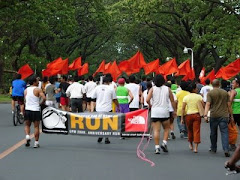









Of course sea turtles are also common in the area. I had a few minutes of 'bonding moment' with a hawksbill sea turtle, swimming with this elegant creature just 1-2 feet away. Amazing!
Another first for me was to see a monstrous lone Jackfish (talakitok), it is at least 3/4 of my total body size, maybe even more. I momentarily froze by the glimpse of it, unfortunately - it swam behind me, just a mere 2 meter away, so I only saw it briefly. But the size is really something for the books!
Corals abound in different shapes, sizes and colors - a truly awesome underwater paradise. Mabini/ Anilao is already spectacular - and Apo Island is probably an equal rival.
One message from this trip; the local community worked hard (and still working hard) to preserved their marine treasures. They've worked together to stop unsustainable fishing methods (ex. dynamite w/c destroys the coral reef), educated their community on conservation work - and after years of patience, they are finally earning their pay. A healthier reef gave them more bountiful fish catch. On top, eco-tourism (divers) frequent the place and hence, provide more profits for the community.
"Save the reef and save our future."

